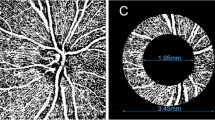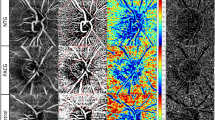Abstract
Purpose
The aim of this study was to assess the possibility of discriminating a narrow and occludable chamber angle by means of digital gonioscopy.
Methods
In a prospective controlled clinical study 40 eyes of 40 patients were enrolled. 20 patients that had suffered acute angle closure glaucoma (ACG) on the fellow eye were compared to 20 patients with open angle glaucoma (OAG). Anterior segment imaging with SL-OCT (Heidelberg Engineering, Heidelberg, Germany) enabled the delineation, by means of automatic signal analysis, of several important parameters of the anterior chamber angle region, which were compared to those revealed from direct contact glass gonioscopy and ultrasound biometry.
Results
The anterior segment structures were automatically recognized by the SL-OCT software in 70 % of the ACG patients and in all of the OAG cases (100 %) (p = 0.025). Anterior chamber angle (ACA) was 15.55° ± 6.92° in the ACG group and 34.6° ± 8.9° in the OAG group, whereas angle opening distance (AOD) was 199.55 ± 62.29 μm in ACG and 452.67 ± 123.91 μm in OAG. A good correlation was found in the direct gonioscopic findings (r = 0.85, p < 0.001), but there were significant differences between both groups (p < 0.001). Mean real central anterior chamber depth (rACD) was evaluated to be 1.75 and 2.79 mm in ACG and OAG, respectively, showing a significant difference (p < 0.0001) and the highest (although not statistically significant) sensitivity and specificity above all other parameters tested in discriminating between OAG and ACG eyes. Discrimination criteria revealed a relevant narrowing of the anterior chamber angle region for values below 22° (ACA), 276 μm (AOD) and 2.08 mm (rACD).
Conclusions
Digital gonioscopy by means of SL-OCT allowed a non-invasive and objective imaging of the anterior chamber configuration that could be used as a screening method for narrow and occludable angles. The method could contribute to a timely identification of angle closure and alert clinicians to further determine whether a peripheral iridotomy should be performed.



Similar content being viewed by others
References
Quigley HA, Broman AT. The number of people with glaucoma worldwide in 2010 and 2020. Br J Ophthalmol. 2006;90:262–7.
Foster PJ. The epidemiology of primary angle closure and associated glaucomatous optic neuropathy. Semin Ophthalmol. 2002;17:50–8.
Nolan WP, Aung T, Machin D, Khaw PT, Johnson GJ, Seah SK, et al. Detection of narrow angles and established angle closure in Chinese residents of Singapore: potential screening tests. Am J Ophthalmol. 2006;141:896–901.
Nolan WP, Foster PJ, Devereux JG, Uranchimeg D, Johnson GJ, Baasanhu J. YAG laser iridotomy treatment for primary angle closure in East Asian eyes. Br J Ophthalmol. 2000;84:1255–9.
Foster PJ, Devereux JG, Alsbirk PH, Lee PS, Uranchimeg D, Machin D, et al. Detection of gonioscopically occludable angles and primary angle closure glaucoma by estimation of limbal chamber depth in Asians: modified grading scheme. Br J Ophthalmol. 2000;84:186–92.
Devereux JG, Foster PJ, Baasanhu J, Uranchimeg D, Lee PS, Erdenbeleig T, et al. Anterior chamber depth measurement as a screening tool for primary angle-closure glaucoma in an East Asian population. Arch Ophthalmol. 2000;118:257–63.
Kashiwagi K, Tokunaga T, Iwase A, Yamamoto T, Tsukahara S. Usefulness of peripheral anterior chamber depth assessment in glaucoma screening. Eye. 2005;19:990–4.
Hoerauf H, Wirbelauer C, Scholz C, Engelhardt R, Koch P, Laqua H, et al. Slit-lamp-adapted optical coherence tomography of the anterior segment. Graefes Arch Clin Exp Ophthalmol. 2000;238:8–18.
Wirbelauer C, Scholz C, Hoerauf H, Pham DT, Laqua H, Birngruber R. Noncontact corneal pachymetry with slit lamp-adapted optical coherence tomography. Am J Ophthalmol. 2002;133:444–50.
Wirbelauer C, Karandish M, Haberle H, Pham DT. Noncontact goniometry with optical coherence tomography. Arch Ophthalmol. 2005;123:179–85.
Wirbelauer C, Gochman R, Pham DT. Imaging of the anterior eye chamber with optical coherence tomography. Klin Monatsbl Augenheilkd. 2005;222:856–62.
Karandish A, Wirbelauer C, Häberle H, Pham DT. Reproducibility of goniometry with slitlamp-adapted optical coherence tomography. Ophthalmologe. 2004;101:608–13.
Karandish A, Wirbelauer C, Häberle H, Pham DT. OCT-goniometry before and after iridotomy in angle-closure glaucoma. Ophthalmologe. 2005;103:35–9.
Saw SM, Gazzard G, Friedman DS. Interventions for angle closure glaucoma: an evidence-based update. Ophthalmology. 2003;110:1869–79.
Wang NL, Wu HP, Fan ZG. Primary angle closure glaucoma in Chinese and Western populations. Chin Med J. 2002;115:1706–15.
Radhakrishnan S, Rollins AM, Roth JE, Yazdanfar S, Westphal V, Bardenstein DS, et al. Real-time optical coherence tomography of the anterior segment at 1310 nm. Arch Ophthalmol. 2001;119:1179–85.
Sakata LM, Lavanya R, Friedman DS, Aung HT, Gao H, Kumar RS, et al. Comparison of gonioscopy and anterior segment ocular coherence tomography in detecting angle closure in different quadrants of the anterior chamber angle. Ophthalmology. 2008;115:769–74.
Nolan WP, See JL, Chew PT, Friedman DS, Smith SD, Radhakrishnan S, et al. Detection of primary angle closure using anterior segment optical coherence tomography in Asian eyes. Ophthalmology. 2007;114:33–9.
Leung CK, Li H, Weinreb RN, Liu J, Cheung CY, Lai RY, et al. Anterior chamber angle measurement with anterior segment optical coherence tomography: a comparison between slit lamp OCT and Visante OCT. Invest Ophthalmol Vis Sci. 2008;49:3469–74.
Sakata LM, Wong TT, Wong HT, Kumar RS, Htoon HM, Aung HT, et al. Comparison of Visante and slit-lamp anterior segment optical coherence tomography in imaging the anterior chamber angle. Eye (Lond). 2010;24:578–87.
Lee KS, Sung KR, Kang SY, Cho JW, Kim DY, Kook MS. Residual anterior chamber angle closure in narrow-angle eyes following laser peripheral iridotomy: anterior segment optical coherence tomography quantitative study. Jpn J Ophthalmol. 2011;55:213–9.
Panek WC, Christensen RE, Lee DA, Fazio DT, Fox LE, Scott TV. Biometric variables in patients with occludable anterior chamber angles. Am J Ophthalmol. 1990;110:185–8.
Sihota R, Vashisht P, Sharma A, Chakraborty S, Gupta V, Pandey RM. Anterior segment optical coherence tomography characteristics in an Asian population. J Glaucoma. 2012;21:180–5.
Narayanaswamy A, Sakata LM, He MG, Friedman DS, Chan YH, Lavanya R, et al. Diagnostic performance of anterior chamber angle measurements for detecting eyes with narrow angles: an anterior segment OCT study. Arch Ophthalmol. 2010;128:1321–7.
Otori Y, Tomita Y, Hamamoto A, Fukui K, Usui S, Tatebayashi M. Relationship between relative lens position and appositional closure in eyes with narrow angles. Jpn J Ophthalmol. 2011;55:103–6.
Leung CK, Palmiero PM, Weinreb RN, Li H, Sbeity Z, Dorairaj S, et al. Comparisons of anterior segment biometry between Chinese and Caucasians using anterior segment optical coherence tomography. Br J Ophthalmol. 2010;94:1184–9.
Grewal DS, Brar GS, Jain R, Grewal SP. Comparison of Scheimpflug imaging and spectral domain anterior segment optical coherence tomography for detection of narrow anterior chamber angles. Eye (Lond). 2011;25:603–11.
Shabana N, Aquino MC, See J, Ce Z, Tan AM, Nolan WP, et al. Quantitative evaluation of anterior chamber parameters using anterior segment optical coherence tomography in primary angle closure mechanisms. Clin Experiment Ophthalmol. 2012;40:792–801.
Foster PJ, Aung T, Nolan WP, Machin D, Baasanhu J, Khaw PT, et al. Defining “occludable” angles in population surveys: drainage angle width, peripheral anterior synechiae, and glaucomatous optic neuropathy in east Asian people. Br J Ophthalmol. 2004;88:486–90.
Conflicts of interest
A. Tzamalis, None; D.-T. Pham, None; C. Wirbelauer, None.
Author information
Authors and Affiliations
Corresponding author
About this article
Cite this article
Tzamalis, A., Pham, DT. & Wirbelauer, C. Comparison of slit lamp-adapted optical coherence tomography features of fellow eyes of acute primary angle closure and eyes with open angle glaucoma. Jpn J Ophthalmol 58, 252–260 (2014). https://doi.org/10.1007/s10384-013-0301-5
Received:
Accepted:
Published:
Issue Date:
DOI: https://doi.org/10.1007/s10384-013-0301-5




